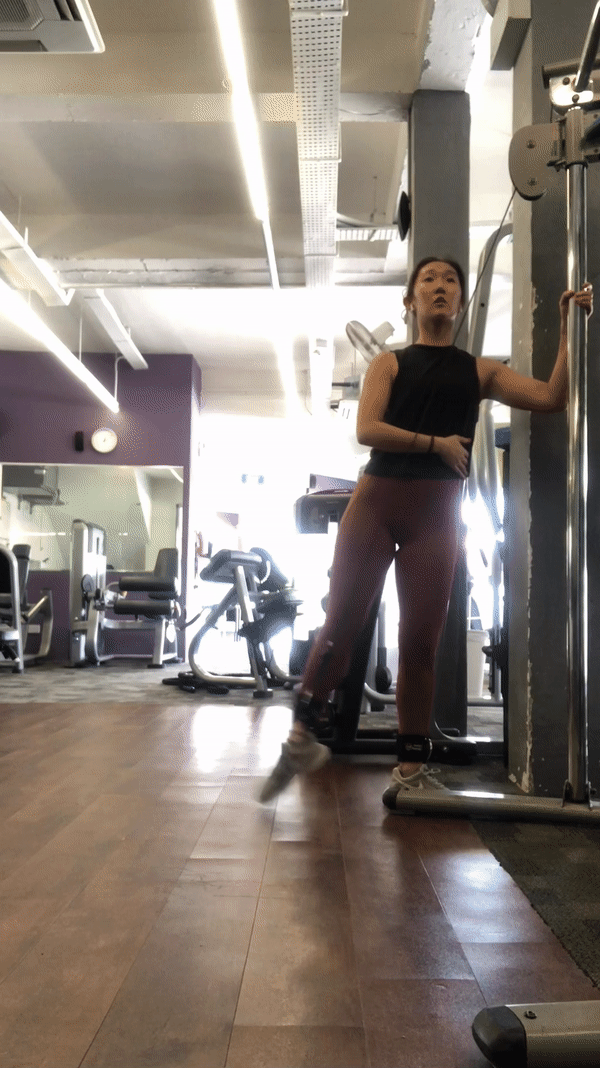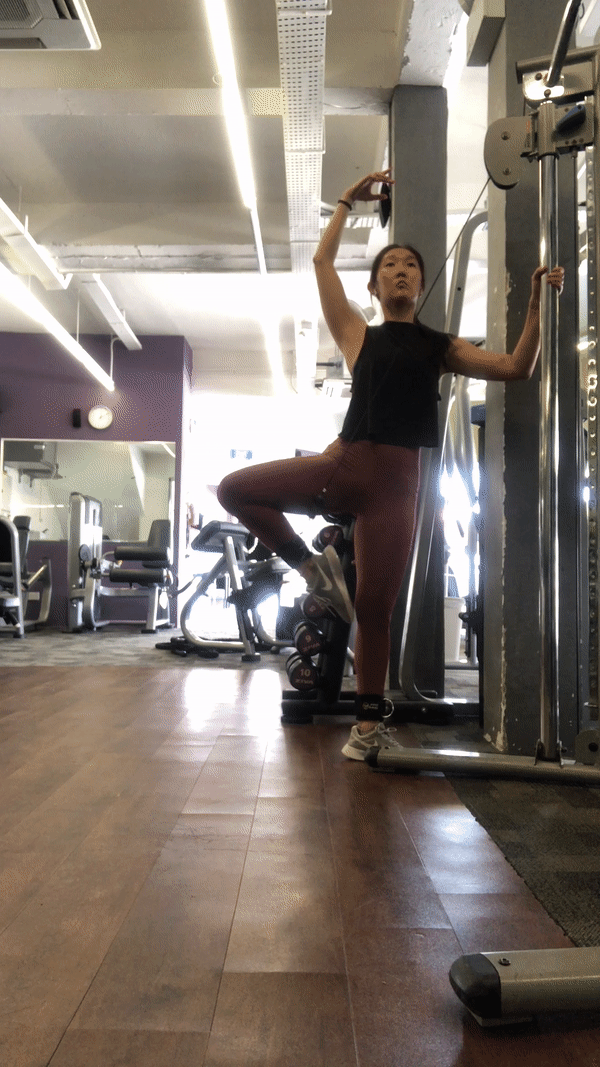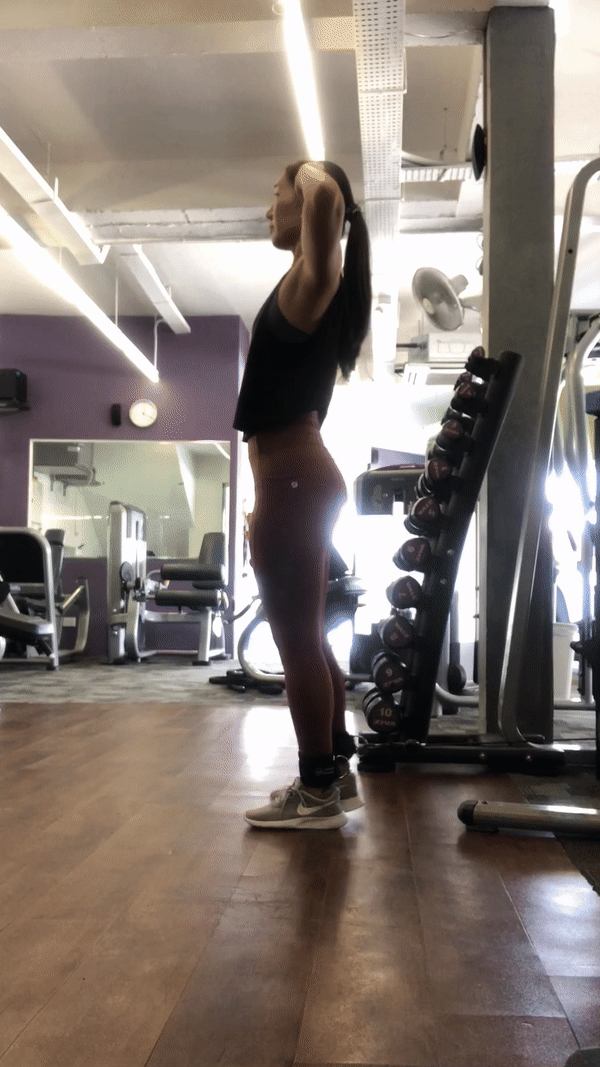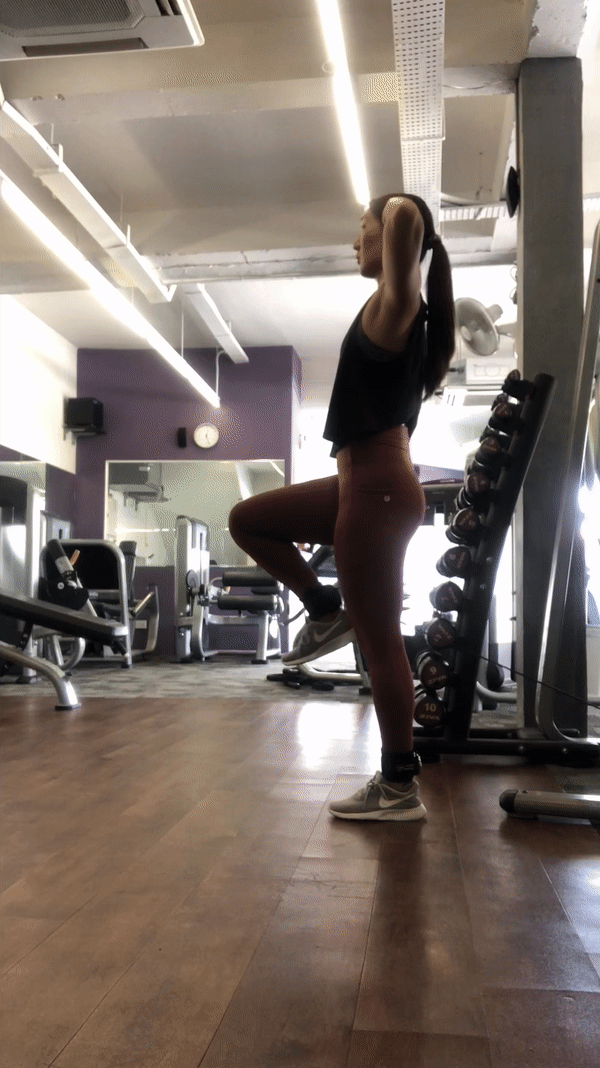Welcome to the second edition of my series on functional and resistance exercises for dancers! Today we will be focusing on the lower body — hips, glutes, and legs (including the quads, hamstrings, and calf muscles).
Be sure to check out my first post on Upper Body Exercises for Dancers to make sure you have a balanced full-body workout. Foot exercises will not be included in this post as I have already written some of my favorite exercises here! Stay tuned for a final edition on core coming soon…
Now, we all know that the main focus of ballet is #legs. Turn out is one of the first things we learn in ballet and is the quintessential component of classical dance. However, today we will be working mostly in parallel. Working in parallel is actually very beneficial for dancers to revert to every once in a while; it reinforces our body’s natural alignment and corrects muscle imbalances. Building correct movement patterns, balance, endurance, and strength in parallel before transitioning to external rotation (turn out) can enhance our dancing overall. Plus, now you don’t have to think about holding turn out and just focus on the exercise itself!
Remember, the whole point of cross training is to strengthen our weaknesses so that we are able to dance better. Sometimes, it doesn’t make sense to do the exact same movement patterns we already do in ballet class just with weight and resistance. The key here is creating a workout program that will compliment our ballet technique and utilize our muscles in similar ways to how we use them in dance. This means working in parallel over turn out, active and dynamic stretching over static stretching, and overall compound strength exercises. When we finish, your body will not only be stronger in a dance context, but stronger, healthier, and more resistant to injury overall.
Muscular System
Remember our huge diagram of the human muscular system:

Let’s zoom in today on the lower half:
I mentioned this countless times in my upper body blog, but again: don’t forget about your back and core. All the global and local muscles around the spine stabilize the trunk to prevent excessive motion. Remember to activate the core muscles and hold your posture straight for balance and stability during each exercise. (We want very limited trunk movement to protect our central nervous system – the spinal cord).
Exercise List
All the exercises listed are compound except for your favorite calf raises (releves/rises) at the end. Rises tend to get boring for me to do alone as a separate exercise set, so I usually like to superset with them. Superset is when you perform exercises in rapid succession. I love to superset calf raises after squats or RDL to complement the main exercise and build muscle stamina — perfect for when you're absolutely exhausted towards the end of a combination or variation but need to push just a little bit more to finish it out strong!
1. Squats
Main muscle group: quads
Movement pattern: flexion and extension
Equipment: bodyweight or barbell
Related ballet steps: plie
Progression: squat releve and squat jumps

What is the first combination at the start of ballet class? Plies. Let’s kick off our workout in the same way. Squats are functional plies; slightly different movement pattern, but the same target muscles. With a plie, we think about keeping our posture completely vertical with our tailbone dropping straight down to the ground. With a squat, our upper body will pitch forward so that our back slopes on a diagonal. For a squat, the feeling of your butt sticking out is a good thing as we want to keep our spine straight. Rounding of the back in any exercise is a no-go and will make you very prone to back injuries.
A couple things to keep in mind while squatting… 1) knees over toes — same as ballet. 2) keep your feet in parallel — remember, we aren’t doing any turn out. 3) only lean forward as much as needed — try not to lean forward excessively and keep the back straight. 4) just because there is a forward lean doesn’t mean lower back arch — we want to keep our back flat with a neutral pelvis and head in line with our spine, so make sure not to look up or drop the neck. 5) squat depth — if you can ass to the grass whilst keeping proper technique, go ahead by all means, but aim for at least the femur parallel to the floor (90 degree knee bend).
The primary purpose of a squat or plié is power — power for releves, pirouettes, and jumps. It’s not just a knee bend. Think about this while doing each rep. When you bend, visualize the energy you are accumulating. Then, imagine the motion like a geyser — energy shooting up and out at a rapid pace as you straighten the knees. I mentioned this same paradigm when I was talking about chest fly in my previous blog. We want a slow loading phase (bending in the squat) and a fast unloading phase (straightening) to efficiently produce the most force possible. In exercise science terms, this is called the stretch-shortening cycle. Progress to squat releve and squat jumps to further practice this concept.
2. Single Leg Press Releve
Main muscle group: quads, calves, glutes
Movement pattern: flexion and extension
Equipment: machine
Related ballet steps: fondu, single leg strength, control, and endurance
Progression: external rotation

Natural progression in both exercise and ballet is from a two leg stance to single leg. In ballet, we always introduce steps that utilize both legs first, like plies and sautes, then move to the single leg version (fondu and temps leve).
Since leg press involves a machine modality which is easier for the body to exercise than free weights or cables, increase the difficulty of the exercise by focusing on one leg at a time. Exercise machines isolate the targeted muscles under a controlled ROM, so it is perfect to experiment with different movement patterns. Try a single leg press first to feel that fondu action; keep thinking about that stretch-shortening cycle process here too! Then, progress to a single leg press + calf raise to mimic a fondu releve. Finally, you can also try a leg press + jump on very light weight (no more than 10% of your body weight). This one reminds me of the various jump board exercises on a pilates reformer. Remember to adjust the weight to your preference — if going for strength, go for heavier loads and low reps, but if your aim is endurance, like 32 fondu releves for fouetté preparation, then do lighter weight and even time yourself or do your set to the coda music!
3. Multiplanar Lunge
Main muscle group: legs
Movement pattern: multiplanar flexion
Equipment: bodyweight or dumbbells
Related ballet steps: transfer of weight and change of direction
Progression: add retire

There are many different types of lunges to do… so try them all in this exercise! Lunges are very customisable to your program and what you want to work on. I recommend you do multiplanar lunges to practice two important concepts in dance — transfer of weight and change of direction. Many beginners in dance struggle with their body coordination and sense of space. Because lunges require the body to move out of one’s center of gravity and then return to the center, it helps practice transfer of weight. Adding in the multiplanar aspect to the lunges also forces you to practice change of direction at the same time. More advanced combinations and steps in ballet, like grand allegro require a certain level of footwork agility with quick change of direction. These multiplanar lunges will kill two birds with one stone and help you increase your grasp of your body in space and proper weight placement.
Finally, level up your lunges to the final stage by adding a retire passé balance after each lunge returning to the center. Especially if you do regular forward or reverse lunges, this sequence mimics the pirouette preparation pattern. Pushing the working leg into retire after the step out lunge makes you to find your center of gravity as soon as possible, challenging your balance and stability. This is also great for developing better proprioception for long adagio combinations!
4. Deadlift
Main muscle group: everything
Movement pattern: entire body flexion
Equipment: bodyweight, dumbbells, barbell
Related ballet steps: overall full body strength, especially core
Progression: more resistance

What is lifting? Lifting is picking something up off the ground. Yep, deadlifting is that simple (in theory). Deadlift is one of the big three lifts and is a pure expression of strength that involves the entire body. I personally have a love-hate relationship with deadlifts. It’s an exhausting exercise (I’m literally huffing and puffing after every rep), but I can feel a difference in my body after completing all my sets, especially my core and back. My core feels more connected to the rest of my body in a way that other exercises don’t produce and my back feels like a concrete wall.
For deadlifting, it’s not about lifting heavy and bulking up huge muscle size. We want strength but not hypertrophy. Focus on form first. The most important thing about deadlift is to keep your back straight and remember your prime movers are your legs and core. Any rounding in your back risks injury, especially with such heavy weight. Increase slowly; dancers aren’t powerlifters so it’s ok not to deadlift four plates like big gym bros. Brace your core when initializing the movement. If you’re concerned about your posture, try a lifting belt. The thick wide belts help to engage intra abdominal pressure to keep the back straight when deadlifting or squatting. Do your deadlifts at the beginning of your workout for maximum effect — at the end you’re already fatigued from other exercises, which creates a higher risk environment for poor form and injury. You will feel strength like never before after incorporating deadlifts into your program!
5. Romanian Deadlift (RDL)
Main muscle group: back, hamstrings, calves
Movement pattern: hip hinge
Equipment: bodyweight, dumbbells, barbell
Related ballet steps: posterior kinetic chain strength
Progression: single leg RDL

Another type of deadlift I highly recommend is the RDL. RDL is a different exercise than the conventional deadlift or sumo deadlift in that the primary movement pattern is a hip hinge with only a small bend in the knees. The target muscles for RDL is the entire posterior kinetic chain — the backside of the body. For RDL, really think about sticking out your butt to commence the hip hinge movement. Some trainers like to say, “visualize you are pushing a button behind you with your butt.”
The natural progression of a regular two leg RDL is single leg RDL. However, I think that single leg RDL is a completely different feeling than normal RDL. The focus of single leg RDL becomes balance and stability of the standing leg, which is also the working leg, over general post kinetic chain strength. It is really difficult to do with weight, especially if you lack the balance and don’t have consistent technique, so start with bodyweight first. Sometimes I alternate workouts of RDL and single leg RDL depending on if I want to work on posterior strength or balance and proprioception. Or, if you’re really enthusiastic, superset your RDL with bodyweight single leg RDL!
6. Cable Hip Adduction + Abduction
Main muscle group: inner thighs and external rotators
Movement pattern: adduction and abduction
Equipment: resistance bands or cables
Related ballet steps: hip flexibility and strength (weighted dynamic stretching)
Progression: try rond de jambe or developpe instead of leg lifts/grand battements
Now, let’s get into some hip exercises. Hips are very important in dance, because they are the biggest source of your turn out, allow for high extensions, and create buoyant jumps. Cable hip adduction and abduction will work both the inner and outer thighs for hip flexibility, ROM, and strength.
Cable hip-ductions are very customizable as well for specific muscle activation – try parallel or turn out, different movement patterns, and placement of the cables or resistance bands. Leg lifts (abduction) – whether performed in parallel or turn out, the cables will be placed at the bottom of the rack and the target muscles will be the external rotators. Leg lowers (adduction) – I recommend only doing this one in turned out, since the ROM is full a la second extension. The cables will be placed at the top of the rack and will work the inner thighs. This one is basically a full set of dynamic stretches because the cable will automatically pull your leg to its maximum height every rep. Other fun movement patterns to try would be developpes or rond de jambes (both adduction).
I find that adduction is a more versatile exercise than abduction as it allows for a greater ROM and more interesting movement patterns, as well as heavier weight loads. Even for me after months of hip abduction, I am still doing light loads, even though they feel very heavy. Whereas with adduction, the motions are downward and test flexibility, making it easier to do heavier loads. Try a variety of patterns; you even can superset them together for maximum effect!
7. Cable Hip Flexion
Main muscle group: hip flexors
Movement pattern: flexion
Equipment: resistance bands or cables
Related ballet steps: front and side extension
Progression: do exercise without assistance (like, without holding onto anything)
A very popular misconception taught in ballet is to not use the hip flexors or quads for any leg lifting movement and instead opt to use the inner thighs and hamstrings. This is because dancers have a long held fear that using the hip flexors/quads will bulk up the front of the legs, resulting in thick thunder thighs that are obviously oh so unelegant. But this is completely impossible and false! The hip flexors (iliopsoas) are the primary muscles that lift the leg to the front and side, not the hamstrings. In addition, the quads are the muscle group that stretch the knee; the hamstrings bend the knee joint. It’s basic anatomy that somehow got twisted around in the ballet world!
If you find yourself struggling to lift your leg devant or decote, it may be because you lack strong hip flexors. Try this exercise only in parallel to get the full effect of utilizing the front of the hips only. Superset your hip flexion with extension, like stretching your leg from retire passe into full developpe using the quads. For an extra challenge to your balance, do this exercise without holding onto anything for assistance.
8. Cable Glute Kickback
Main muscle group: glutes
Movement pattern: adduction
Equipment: resistance bands or cables
Related ballet steps: arabesque
Progression: do exercise without assistance

To complete all directions of extension, cable glute kickback works on our arabesque height and line. Remember the butt muscles lift the leg in arabesque, not the back or hamstrings. (However, back flexibility and strength are very important to hold the leg in arabesque and achieve a higher arabesque).
Place the cables at the bottom of the rack. Use light weight first to establish a full ROM for the highest arabesque possible. I usually like to start in parallel and then rotate as I lift my leg in arabesque (you can open your hip). Keep the supporting leg in a fondu position for stability and your weight forward. Gradually increase the weight to feel a greater glute workout, but remember to maintain your posture and stable supporting leg. With all these cable exercises, you can also replace the cable machine with resistance bands for a simpler set up. Tie one end of the band around the ankle and step on the end of the other side. More resistance will occur with a strong band or by stepping closer to the middle of the band, making the length of the band shorter.
9. Glute Bridge / Hip Extension / Hip Thrusts
Main muscle group: glutes, hamstrings
Movement pattern: flexion
Equipment: bodyweight, free weights, or other exercise modalities
Related ballet steps: back and core alignment
Progression: single leg

Whatever the name of this exercise is called… it's a perfect one to do if you lack exercise equipment! All you need is a mat to protect your backside lying on the floor. If you want to do with weights however, you have to go through the trouble to set up the bench and barbell properly. Glute bridge is a great exercise for the posterior chain, namely the butt and hamstrings. But it is also a great exercise to find your pelvic and spine alignment since you’re performing this exercise in a supine position. Before starting my reps, I always like to move through my pelvic placement a few times to activate my core muscles and practice rolling through each position (posterior, neutral, and anterior pelvic tilt). I wrote about this little warm up routine here in a previous blog.
Glute bridge is also a very good exercise for different exercise modalities to help increase difficulty and muscle engagement. For example, to keep your knees tracking over your toes and add some inner thigh activation, place a small ball between your knees. You can also use a resistance band for the same effect except for the external rotator muscles. Weights can also be placed on your hips if you’re really gunning for maximum glute strength. In addition, superset your normal glute bridge with single leg bridges right after to target one leg at a time, thinking about building a strong supporting side and leg.
10. Calf Raises
Main muscle group: calves
Movement pattern: extension
Equipment: riser for increased range of motion
Related ballet steps: releve or demi pointe
Progression: single leg

As I wrote earlier, I rarely do a set of calf raises or releves on their own; I like to superset or combine them into other exercises to make the exercise more difficult, more akin to ballet steps, or to build muscle endurance. Rises can be added to all the exercises above, except for the cable machine ones. (Yes, you can do rises lying down in the glute bridge! Really think about using your ankles and metatarsals for these.)
I highly recommend training your calf raises on a riser – a platform or box a couple inches off the ground. Place your toes on the platform edge so that your heels hang down. Feel the stretch in the back of your legs. Now, push up to your highest demi pointe. A raised platform helps to increase your demi pointe ROM, great for dancers who want to strengthen their calves and ankles for pointe work. Try all variations of this – single leg, plie-releve, straight leg rises, forced arch rises, adding weight… Get creative as each variation works the calves and ankles in slightly different ways!
TL;DR:
Leg days are fun because we can really connect our weight training to our dance training and get super strong~
Sample Upper Body Workout (reps x sets)
To do all the exercises above in one workout would be too much to be effective. I have created two sample workouts below.
Lower Body Var 1
Squats + Calf Raises (superset) | 10 x 5 or pyramid*
RDL | 10 x 4
Hip Flexion | 10 x 4 on each leg
Glute Kickback | 10 x 4 on each leg
Multiplanar Lunges | 10 x 2 on each leg
Lower Body Var 2
Deadlift | 10 x 5 or pyramid*
Single Leg Press Releve + Squat Jumps (superset) | 10 x 4 on each leg
Hip Abduction / Adduction | 10 x 4 on each leg
Glute Bridge | 10 x 4
*Pyramid is a training technique whereby each set, the weight progresses and the number of reps decrease. I like to do pyramid on my biggest compound exercises to train for maximum strength.










Comments